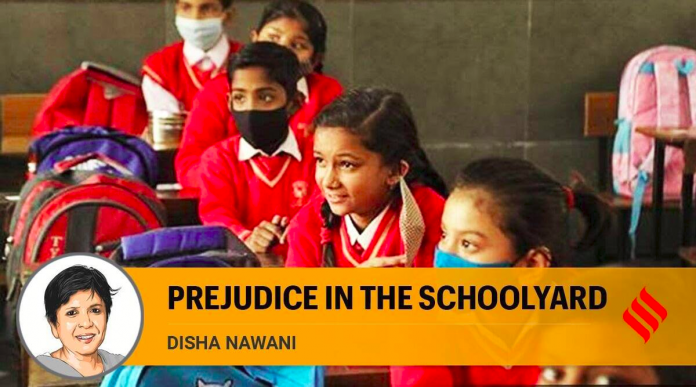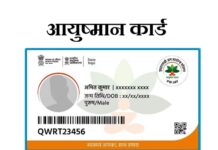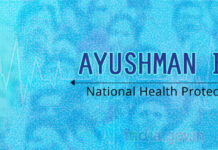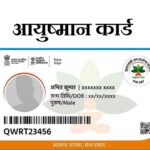Disha Nawani writes: For each child, the social reality outside will also impact what she experiences inside school.
There is no reason to believe that there is a connection between “what children learn in schools” and recent events such as the lynching of a Dalit youth to death in Punjab, social media tweets against actor Shah Rukh Khan for the arrest of his son, Aryan Khan and uproar over Fabindia advertising Diwali as Jashn-e-Riwaaz. Underlying these events are deep-rooted prejudices, stereotypes, expressions of self-righteousness, mistrust and hatred for those “different” from us — in terms of gender, religion, caste and class. A more appropriate question to ask perhaps would then be, “what is the role of schools” in the formation of prejudices/stereotypes.
We must begin by acknowledging that schools are a microcosm of the larger society. If there are cleavages in society, they will get reflected in schools. For example, a Dalit girl’s experience will be different from a Brahmin boy, even if they go to the same school. This is because, for each child, the social reality outside of school will also impact what he experiences inside schools because of messages, either manifest or hidden, transmitted in schools.
Now let us examine how schools treat their students. On the one hand, they have homogenising rituals such as mandating a school uniform, common assembly and common modes of teaching, evaluating and disciplining imposing the same code of conduct/expectations from everyone. On the other hand, there are rituals that are meant to mark/grade and separate students from each other. This is most evident in the way high achievers are rewarded, made to wear marks of distinction, sometimes even physically separating them from the so-called weaker sections.
This would lead us to believe that schools give little weightage to different forms of capital — economic, social and cultural resources that students may or may not possess depending on where they come from and how that influences their performance in school. Instead of acknowledging diversity, stratification and associated inequality and discrimination schools pretend that all is well in the world outside and shut themselves off from divergent experiences that different children may have. There are safeguards in the form of syllabi, prescribed textbooks and focused examinations that ensure the child’s world — knowledge, language, culture, experiences — is not allowed entry into the school. While this is made explicit in all formal and informal communication to students and their parents, there is another way in which most students’ experiences are distorted in the classroom. Textbooks, the central pivot around which teaching-learning revolves, are responsible for perpetuating symbolic violence against certain social groups living on the margins of society by either ignoring or misrepresenting them.
For instance, women, and other social groups on the gender spectrum, people with disabilities, hardly find any presence in textbooks. If they do, they are caricatured or presented in a poor light. There are examples galore of women shown as being dumb, people with disabilities as helpless or even wicked, people from lower classes as being dirty and lazy, Dalits as being inferior and deserving of hardships and tribals as being steeped in orthodoxy and superstition. Minorities, either linguistic or religious, also meet the same fate. Loose, irresponsible statements are made in textbooks, which are then reinforced by teachers in the classroom. Social inequalities present in the real world are thus replicated inside schools.
Another serious limitation with our textbooks is the tendency to keep them sanitised, with no mention of any social evil or conflicts. This is done to keep young minds away from the ill effects of all that is bad in society. Ironically, a child experiencing discrimination day in and day out in his real life is transported to a make-believe world where all is well. A child wearing a skull cap being teased outside the class and accused of being a terrorist on entering the classroom reads a textbook, which says, “Hindu, Muslim, Sikh, Isai apas mein bhai bhai”. Nazia Erum, in her book Mothering a Muslim, based on systematic research in schools across several cities in India shows how Muslim children are teased by being called “terrorist” and “Pakistani”. Similarly, a Dalit child living a life on the fringes of his village is given to believe that all is well with school and society. Sociologists, Murali Krishna and Govardhan Wankhede, in their autobiographies, poignantly present experiences of discrimination and humiliation they faced in their childhood both inside and outside school.
Added to this is the pedagogic necessity to passively accept whatever is taught in schools. Prejudices become our lens, shaping the way we look at the world and others around us. As adults, we cling to them as they help us justify our misdeeds against others.
The National Curriculum Framework 2005 radically tried to shift the nature of schooling in India. Social science textbooks, particularly Social and Political Life, were outstanding in several ways. Instead of adopting an attitude of an ostrich they acknowledged inequity in society, brought in subaltern literature and voices, and accorded legitimacy to multiple world views. Contrary to the spirit in which NCF was written, one finds it difficult to understand why sacrifice is espoused and valued in the National Education Policy, 2020. Eklavya’s sacrifice of his thumb as gurudakshina to Dronacharya is celebrated in our textbooks rather than being condemned. In a grossly unequal society, it is not difficult to imagine that who will be expected to sacrifice and to whom, and the “we” in school and society will continue to engage in acts of violence. While we take pride in inflicting violence on those weaker than us, with each such act, we become more dehumanised.















